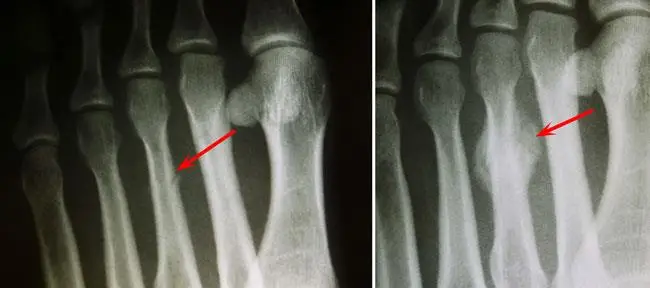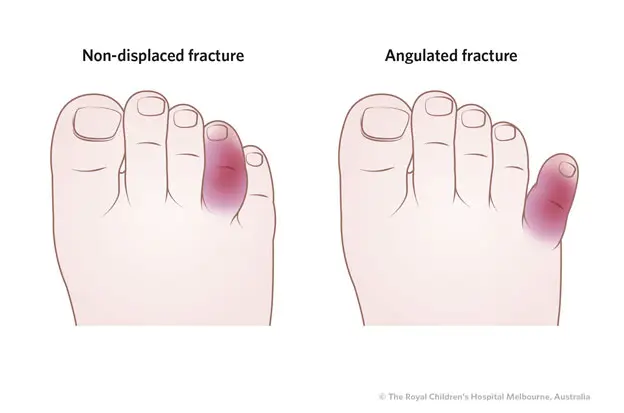Toe and Forefoot Fractures
The Foot & Ankle Center
at Modern Orthopedics of New Jersey
Experience Top Orthopedic Care
Schedule Now
Book an appointment to meet with a Board Certified Orthopedic Physician.
Paramus
72 Route 17 North
Paramus, NJ 07652
Wayne
2025 Hamburg Turnpike
STE C, Wayne, NJ 07470
Parsippany
3799 US-46
#207, Parsippany, NJ 07054
How Toe and Forefoot Fractures Present
Toe and Forefoot Fractures – Treatment and Surgery in Wayne, Parsippany & Paramus, NJ
Toe fractures typically present with swelling, bruising, and pain localized to the injured toe. The toe may appear misaligned or deformed, and movement may be limited or painful. X-ray imaging can confirm the fracture, showing a break in the bone.
Forefoot fractures, such as metatarsal fractures, can cause similar symptoms but involve the long bones in the front of the foot. X-rays reveal breaks or cracks in these bones.

The X-rays above demonstrate the healing course of a third metatarsal fracture. The left image demonstrates the fracture in its acute stage. The image on the right demonstrates a bone callus formed after healing.
Treatment for both toe and forefoot fractures often involves rest, immobilization with a splint or special boot, pain management, and sometimes surgery for severe cases.
Common Symptoms of Toe and Forefoot Fractures
As mentioned above, common symptoms of forefoot fractures include pain localized to the front of the foot, particularly during weight-bearing activities. Swelling, bruising, and tenderness over the affected area are typical. Difficulty walking or bearing weight on the injured foot is common, along with limited range of motion. Deformity or misalignment of the toes may be noticeable in some cases. In severe fractures, there may be an audible snap or pop at the time of injury.
Diagnostic Tests for Toe and Forefoot Fractures
A detailed history and physical examination is the first line of assessment. This includes pressing on affected toes and putting their respective joints through a range of motion, performing a piano key test where metatarsals are put through a range of motion to assess for pain in problem areas. In some instances, there is significant bruising and swelling.
X-ray imaging is necessary for diagnosis and provides detailed views of bone structure, revealing fractures, dislocations, or other complications. In some instances, advanced imaging options, like CT scans or MRI, are required for more extensive/detailed evaluation for diagnosing forefoot fractures and aid in surgical planning. CT scans offer 3D images of the bone structures for better visualization of complex fractures, while MRI scans show soft tissue injuries, including those with ligament and tendon involvement. These imaging techniques guide treatment decisions by providing critical information about fracture type, severity, and potential complications, ensuring optimal care for patients with forefoot fractures.
Seeking Expert Advice From Modern Orthopaedics
Seeking expert care promptly is crucial for forefoot fractures to prevent complications and facilitate proper healing. Upon diagnosis, treatment typically involves (as mentioned above) immobilization, such as with specialized walking boots and casting or splinting, to stabilize the fracture and promote alignment. Pain management is essential and may include medications or therapeutic modalities. In some cases, surgical intervention may be necessary, particularly for displaced or complex fractures. Surgeons realign the bones and may utilize hardware like screws or plates to secure the fracture site. Regular follow-ups with healthcare professionals ensure treatment efficacy and monitor healing progress, optimizing outcomes for individuals with forefoot fractures.
Treatment Approaches for Toe and Forefoot Fractures
Treatment approaches for forefoot fractures vary depending on the severity and specific characteristics of the injury. In greater detail, common strategies to those mentioned prior include:
Immobilization
Mild to moderate fractures often benefit from immobilization using splints, buddy taping (tape adjacent toes together for support), or specialized footwear to stabilize the affected area and promote healing.
Pain Management
Over-the-counter pain medications like acetaminophen or ibuprofen may help alleviate discomfort. Prescription pain relievers may be necessary for severe pain.
R.I.C.E Therapy: Rest, Ice, Compression, and Elevation can reduce swelling and pain. Rest the foot, apply ice packs intermittently, use compression bandages, and elevate the foot above heart level whenever possible.
Physical Therapy
Once healing progresses, gentle stretching and strengthening exercises prescribed by a physical therapist can aid in restoring flexibility and function.
Surgical Intervention: Severe fractures, particularly those involving displaced or fragmented bones, may require surgical intervention. Procedures might involve realignment of bones, internal fixation with screws, plates, or wires, or external fixation devices.
Follow-up Care
Regular monitoring by healthcare professionals ensures proper healing and addresses any complications or concerns that may arise during the recovery process.
Individualized treatment plans should be developed in consultation with healthcare providers to ensure the most effective approach for each patient’s unique circumstances.
Frequently Asked Questions About Toe and Forefoot Fractures
What Not To Do With a Fractured Foot
Avoid putting weight on the fractured foot to prevent further damage or displacement of the bones. Refrain from participating in high-impact activities or sports that could exacerbate the injury. Do not attempt to self-diagnose or self-treat the fracture without consulting a healthcare professional for proper evaluation and management.
How Do You Treat a Fractured Forefoot?
Treatment for a fractured forefoot typically involves immobilization with splints, casts, or specialized footwear to stabilize the injury. Pain management, rest, and elevation are essential. Severe cases may require surgical intervention for realignment and fixation. Follow-up care ensures proper healing and rehabilitation for optimal recovery.
How Long Do You Have To Stay Off a Fractured Foot?
Healing time for a fractured foot varies based on many different health factors, with bones generally requiring 4-8 weeks to mend. Ligament and tendon injuries may need 6-12 weeks. However, individual factors like age, overall health, and injury severity influence recovery. It’s crucial to follow a healthcare provider’s guidance for proper healing and rehabilitation.
What Health Factors Impact Bone Healing?
Health factors impacting bone healing include age, nutrition, smoking, and underlying medical conditions like diabetes or osteoporosis. Adequate intake of calcium, vitamin D, and protein supports bone health. Proper blood circulation and hormone levels are essential. Smoking and certain medications can impede bone healing.

Our Awarded
Specialist
Dr. Einul Chowdhury, DPM, AACFAS
FOOT & ANKLE SURGEON
Meet Dr. Chowdhury
Dr. Einul Chowdhury is a Board Qualified Foot & Ankle Surgeon that specializes in: lower extremity trauma, sports medicine, minimally invasive surgery, & limb deformity correction. Learn more about specialties, training and treatment philosophy by visiting Dr. Ein's full profile page.

A Different Orthopedic Experience.
Treatment Diversity
We offer a comprehensive range of treatments, ensuring personalized, targeted plans for every patient.
Collaborative Care
Our multi-disciplinary approach involves various specialties to provide comprehensive care and recovery.
Patient Focus
We prioritize patient comfort and satisfaction, creating a supportive environment for optimal healing.
Technological Excellence
We utilize cutting-edge technology for precise diagnosis and innovative treatment options.
Skilled Experts
Our team is composed of highly skilled, experienced orthopedic professionals, providing expert care.
Post-Treatment Support
Our robust post-treatment support ensures ongoing patient care through recovery and rehabilitation services.
About Us
Modern Orthopaedics specializes in conditions and treatments of the shoulder, elbow, hand/wrist, hip, knee and foot/ankle with locations in Wayne, Parsippany, and Paramus, NJ.
Serving
Navigation
Our Locations



